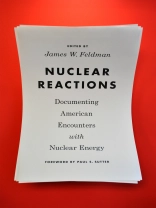Nuclear Reactions explores the nuclear consensus that emerged in post–World War II America, characterized by widespread support for a diplomatic and military strategy based on nuclear weapons and a vision of economic growth that welcomed nuclear energy both for the generation of electricity and for other peaceful and industrial uses. Unease about the environmental consequences of nuclear energy and weapons development became apparent by the early 1960s and led to the first challenges to that consensus.
The documents in this collection address issues such as the arms race, “mutually assured destruction, ” the emergence of ecosystems ecology and the environmental movement, nuclear protests, and climate change. They raise questions about how nuclear energy shaped—and continues to shape—the contours of postwar American life. These questions provide a useful lens through which to understand the social, economic, and environmental tradeoffs embedded within American choices about the use and management of nuclear energy.
Inhaltsverzeichnis
Foreword: Postwar America’s Nuclear Paradox / Paul S. Sutter
Acknowledgments
Introduction | Nature and the Nuclear Consensus in Postwar America
Part One | First Reactions
1. Leslie Groves, Report on the Trinity Test, 1945
2. Harry S. Truman, White House Statement on the Bombing of Hiroshima, 1945
3. Nagasaki Mushroom Cloud, 1945
4. Joseph H. Willits, “Social Adjustments to Atomic Energy, ” 1946
5. Headline Comics, Atomic Man, 1946
6. Arthur H. Compton, “The Atomic Crusade and Its Social Implications, ” 1947
7. H. M. Parker, “Speculations on Long-Range Waste Disposal Hazards, ” 1948
8. General Advisory Committee Reports on Building the H-Bomb, 1949
9. Lewis L. Strauss to Harry S. Truman, 1949
Part Two | Building Consensus
1. National Security Council Report 68, 1950
2. Federal Civil Defense Administration, This Is Civil Defense, 1951
3. Federal Civil Defense Administration, Women in Civil Defense, 1952
4. Dwight D. Eisenhower, “Address before the General Assembly of the United Nations on Peaceful Uses of Atomic Energy, ” 1953
5. Union Carbide and Carbon Corporation, “What does Atomic Energy really mean to you?” 1953
6. Lewis L. Strauss, “My Faith in the Atomic Future, ” 1955
7. Heinz Haber, The Walt Disney Story of Our Friend the Atom, 1956
8. Bureau of Public Roads, A Preliminary Report on Highway Needs for Civil Defense, 1956
9. Walter Reuther, Atoms for Peace: A Separate Opinion, 1956
Part Three | Challenging Consensus
1. Bertrand Russell and Albert Einstein, “The Russell-Einstein Manifesto, ” 1955
2. Roger Revelle and Milner B. Schaefer, “General Considerations Concerning the Ocean as a Receptacle for Artificially Radioactive Materials, ” 1957
3. Atomic Energy Commission, Atomic Tests in Nevada, 1957
4. National Committee for a Sane Nuclear Policy, “We Are Facing a Danger Unlike Any Danger That Has Ever Existed, ” 1957
5. Atomic Energy Commission, Atoms for Peace U.S.A., 1958
6. Barry Commoner, “The Fallout Problem, ” 1958
7. Edward Teller, “The Plowshare Program, ” 1959
8. Office of Civil Defense and Mobilization, Fallout Maps, 1959
9. Herman Kahn and H. H. Mitchell, The Postattack Environment, 1961
10. Margaret Mead, “Are Shelters the Answer?” 1961
11. Women Strike for Peace Milk Campaign, 1961
12. Atomic Energy Commission, Annual Report, 1962
13. John F. Kennedy, “Commencement Address at American University, ” 1963
14. David E. Lilienthal, Change, Hope, and the Bomb, 1963
15. John F. Kennedy, “Address to the American People on the Nuclear Test Ban Treaty, ” 1963
Part Four | Confronting Paradox
1. Glenn T. Seaborg, “Environmental Effects of Producing Electric Power, ” 1969
2. Minnesota Environmental Control Citizens Association, Anti-Nuclear Pamphlet, ca. 1969
3. Lenore Marshall, “The Nuclear Sword of Damocles, ” 1971
4. Calvert Cliffs’ Coordinating Committee, Inc., v. United States Atomic Energy Commission, 1971
5. William R. Gould, “The State of the Atomic Industry, ” 1974
6. Committee on the Present Danger, “Common Sense and the Common Danger, ” 1976
7. Ralph W. Deuster, “Rx for the ‘Back’ of the Cycle, ” 1976
8. Leonard Rifas, All-Atomic Comics, 1976
9. David N. Merrill, “Nuclear Siting and Licensing Process, ” 1978
10. Helen Caldicott, Nuclear Madness, 1978
11. Abalone Alliance, “Declaration of Nuclear Resistance, ” 1978
12. Report of the President’s Commission on the Accident at Three Mile Island, 1979
13. Gloria Gregerson, Radiation Exposure and Compensation, 1981
Part Five | Renewal
1. David E. Lilienthal, Atomic Energy: A New Start, 1980
2. Ronald Reagan, “Address to Members of the British Parliament, ” 1982
3. Nuclear Waste Policy Act of 1982
4. Jonathan Schell, The Fate of the Earth, 1982
5. Ronald Reagan, “Address to the Nation on Defense and National Security, ” 1983
6. Carl Sagan, “The Nuclear Winter, ” 1983
7. Office of Technology Assessment, Nuclear Power in an Age of Uncertainty, 1984
8. Campaign for a Nuclear Free Future, ca. 1984
9. Bernard Lown, “A Prescription for Hope, ” 1985
10. Elizabeth Macias, High-Level Nuclear Waste Issues, 1987
11. Ronald Reagan, “Address to the 42nd Session of the United Nations, ” 1987
12. Editors of the Bulletin of the Atomic Scientists, “A New Era, ” 1991
Epilogue | The Nuclear Present
1. David Albright, Kathryn Buehler, and Holly Higgins, “Bin Laden and the Bomb, ” 2002
2. Allison M. Macfarlane, “Yucca Mountain and High-Level Nuclear Waste Disposal, ” 2006
3. Oregon Department of Energy, Hanford Cleanup: The First Twenty Years, 2009
4. Mark Z. Jacobson, “Nuclear Power Is Too Risky, ” 2010
5. President’s Blue Ribbon Commission on America’s Nuclear Future, Report to the Secretary of Energy, 2012
6. Nuclear Energy Institute, “Nuclear Energy: Powering America’s Future, ” 2013
7. Ken Caldeira, Kerry Emanuel, James Hansen, and Tom Wigley, “To Those Influencing Environmental Policy but Opposed to Nuclear Power, ” 2013
8. Latuff Cartoons, Fukushima Cartoon, 2014
9. John Asafu-Adjaye et al., “An Ecomodernist Manifesto, ” 2015
Index












